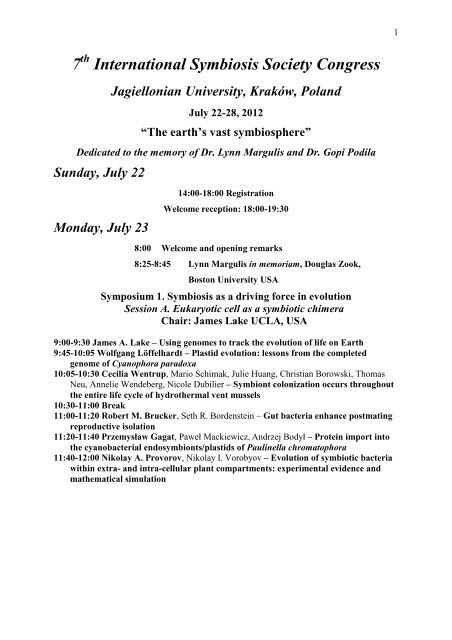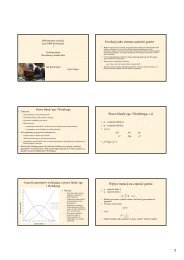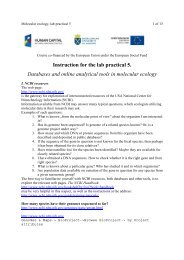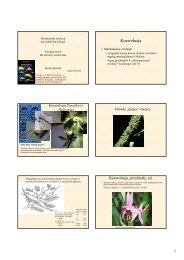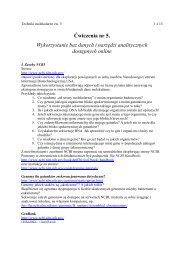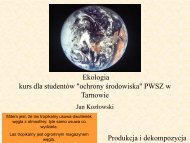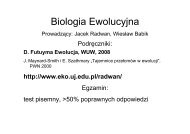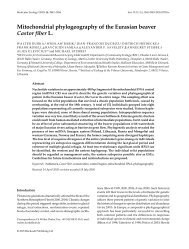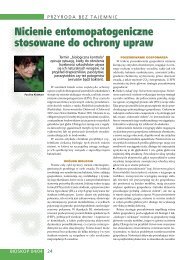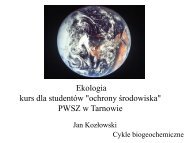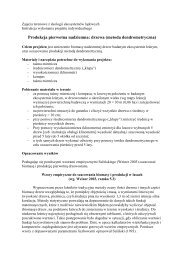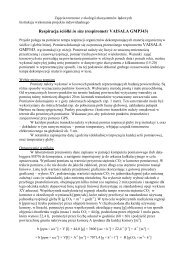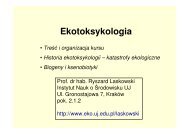7 International Symbiosis Society Congress
7 International Symbiosis Society Congress
7 International Symbiosis Society Congress
You also want an ePaper? Increase the reach of your titles
YUMPU automatically turns print PDFs into web optimized ePapers that Google loves.
1<br />
7 th <strong>International</strong> <strong>Symbiosis</strong> <strong>Society</strong> <strong>Congress</strong><br />
Jagiellonian University, Kraków, Poland<br />
July 22-28, 2012<br />
“The earth’s vast symbiosphere”<br />
Dedicated to the memory of Dr. Lynn Margulis and Dr. Gopi Podila<br />
Sunday, July 22<br />
Monday, July 23<br />
14:00-18:00 Registration<br />
Welcome reception: 18:00-19:30<br />
8:00 Welcome and opening remarks<br />
8:25-8:45 Lynn Margulis in memoriam, Douglas Zook,<br />
Boston University USA<br />
Symposium 1. <strong>Symbiosis</strong> as a driving force in evolution<br />
Session A. Eukaryotic cell as a symbiotic chimera<br />
Chair: James Lake UCLA, USA<br />
9:00-9:30 James A. Lake – Using genomes to track the evolution of life on Earth<br />
9:45-10:05 Wolfgang Löffelhardt – Plastid evolution: lessons from the completed<br />
genome of Cyanophora paradoxa<br />
10:05-10:30 Cecilia Wentrup, Mario Schimak, Julie Huang, Christian Borowski, Thomas<br />
Neu, Annelie Wendeberg, Nicole Dubilier – Symbiont colonization occurs throughout<br />
the entire life cycle of hydrothermal vent mussels<br />
10:30-11:00 Break<br />
11:00-11:20 Robert M. Brucker, Seth R. Bordenstein – Gut bacteria enhance postmating<br />
reproductive isolation<br />
11:20-11:40 Przemysław Gagat, Paweł Mackiewicz, Andrzej Bodył – Protein import into<br />
the cyanobacterial endosymbionts/plastids of Paulinella chromatophora<br />
11:40-12:00 Nikolay A. Provorov, Nikolay I. Vorobyov – Evolution of symbiotic bacteria<br />
within extra- and intra-cellular plant compartments: experimental evidence and<br />
mathematical simulation
2<br />
Symposium 2. Cellular Interactions<br />
Session C. Integrative Processes<br />
Chair: Abdelaziz Heddi, National Institute of Applied Science (INSA),<br />
Lyon, France<br />
9:00-9:45 Abdelaziz Heddi – Insects tolerate endosymbionts with a local immune<br />
response<br />
9:45-10:05 Elizabeth A.C. Heath-Heckman, Suzanne M. Peyer, Margaret J. McFall-Ngai –<br />
Luceat lux vestra: light production and perception in the Euprymna scolopes–Vibrio<br />
fischeri symbiosis<br />
10:05-10:25 François H. Lallier, Isabelle Boutet, Hayat Guezi, Arnaud Tanguy – A<br />
transcriptomic approach of the phenotypic plasticity in a chemotrophic symbiosis,<br />
the deep-sea mussel Bathymodiolus<br />
10:25-10:55 Break<br />
10:55-11:15 Mauricio Henriques Pontes, Kari Lyn Smith, Linda De Vooght, Jan Van Den<br />
Abbeele, Colin Dale – Modulating the functions of PhoP/PhoQ in the transition to<br />
obligate insect-bacterial association<br />
11:15-11:35 Lisa Bauer, Nika Pende, Silvia Bulgheresi – Can you hear me How the<br />
marine nematode Laxus oneistus may perceive and respond to microbes<br />
11:35-11:55 Mary Beth Saffo – A mutualism with parasitic origins: paradoxes of a<br />
surprising three-kingdom symbiosis in marine animals<br />
11:55-12:10 Nedeljka Rosic, Sophie Dove – Origin of mycosporine-like amino acid<br />
biosynthetic genes in coral-dinoflagellate symbiosis<br />
Symposium 1. <strong>Symbiosis</strong> as a driving force in evolution (continued)<br />
Session B. Co-evolutionary mechanisms<br />
Chair: Monika Bright, University of Vienna, Austria<br />
14:00-14:30 Monika Bright, Julia Klose, Mario Schimak, Andrea Nussbaumer – In and out<br />
of symbiosis - connectivity between the host-associated and free-living population of<br />
Candidatus Endoriftia persephone in Riftia pachyptila tubeworms<br />
14:30-14:50 Claudia Vannini, Filippo Ferrantini, Alessandro Ristori, Franco Verni, Giulio<br />
Petroni – Betaproteobacterial symbionts of the ciliate Euplotes: establishment,<br />
replacement and re-replacement of an obligate microbial association.<br />
14:50-15:10 Marc-André Selosse, Yosuke Matsuda, Cécile Palancade, Yasushi Hashimoto –<br />
Convergent evolution of heterotrophy in mycorrhizal symbioses of Monotropoideae<br />
(Ericaceae) and Orchidaceae<br />
15:10-15:30 Nicole Gerardo, Ben Parker, Alice Laughton – Symbionts’ impact on<br />
investment to defense and response to danger by aphids<br />
15:30-16:00 Break<br />
16:00-16:20 Pauliina P. Wäli, Piippa R. Wäli, Kari Saikkonen, Juha Tuomi – Ergot - a seed<br />
pathogen or a mutualistic symbiont<br />
16:20-16:40 Istvan Scheuring, Douglas W. Yu – How to assemble a beneficial microbiome<br />
in three easy steps<br />
16:40-17:00 Mélanie Roy, Juliette Rochet, Patricia Jargeat, Hervé Gryta, Sophie Manzi,<br />
Pierre-Arthur Moreau, Monique Gardes – Coevolution in Alnus-ectomycorrhizal fungi<br />
mutualism: from couples to communities
3<br />
Symposium 2. Cellular Interactions (continued)<br />
Session D. Recognition systems.<br />
Chair: Spencer Nyholm, University of Connecticut, USA<br />
14:00-14:30 Andrew Collins, Tyler Schleicher, Bethany Rader, Spencer V. Nyholm –<br />
Understanding the cellular innate immune response and specificity in the<br />
association between the Hawaiian bobtail squid Euprymna scolopes and the<br />
bioluminescent bacterium Vibrio fischeri<br />
14:30-14:50 Ibtissem Guefrachi, Mikhail Baloban, Eva Kondorosi, Peter Mergaert – The<br />
NCR peptides in legume nodules: effectors for the control of the endosymbiotic<br />
Rhizobium bacteria<br />
14:50-15:10 Natacha Kremer, Eva Philipp, Lars Kraemer, Marie-Christine Carpentier,<br />
Robert Haesler, Melissa A. Altura, Elizabeth A.C. Heath-Heckman, Suzanne M. Peyer,<br />
Bethany A. Rader, Julia Schwartzman, Edward G. Ruby, Philip Rosenstiel, Margaret J.<br />
McFall-Ngai – Initial ‘conversation’ between the bobtail squid and its specific<br />
partner during the establishment of the symbiosis<br />
15:10-15:30 Sergio Svistoonoff, Nicholas Beauchemin, Virginie Vaissayre, Faten<br />
Gholdborne-Gtari, Claudine Franche, Didier Bogusz, Louis S. Tisa – Genome-guided<br />
approaches toward elucidating the signaling mechanisms in the actinorhizal<br />
symbiosis<br />
15:30-16:00 Break<br />
16:00-16:20 Joachim Meessen, Trudi Schaper, Frederike Sill, Claudia Bauten, Sieglinde Ott<br />
– In the initial steps of recognition of lichen symbionts based on morphological<br />
processes of growth patterns<br />
16:20-16:40 Antonin Schmitz, Caroline Anselme, Marc Ravallec, Christian Rebuf, Jean-<br />
Christophe Simon, Jean-Luc Gatti, Marylène Poirié – The cellular immune response<br />
of the pea aphid to foreign intrusion and symbiotic challenge<br />
16:40-17:00 Jiyeun Kate Kim, Jeong Yun Kwon, Sang Hum Han, Yoshitomo Kikuchi,<br />
Hiroshi Nakayama, Takema Fukatsu, Bok Luel Lee – Elucidation of change and<br />
adaptation of symbiotic bacteria in association with host<br />
17:00-17:30 Soukayna Hayek, Philipp Franken, Vivienne Gianinazzi-Pearson –<br />
Mycorrhiza-induced resistance against a root-rot pathogen in Petunia: molecular<br />
mechanisms<br />
17:30-19:00 Poster visits
4<br />
Tuesday, July 2<br />
Plenary presentation<br />
Frank Ryan, University of Sheffield, United Kingdom<br />
Symbiotic viruses and the concept of a holobiontic genome<br />
8:00-8:45<br />
Symposium 1. <strong>Symbiosis</strong> as a driving force in evolution (continued)<br />
Session E. Horizontal gene transfer and the role of viruses<br />
Chair: Takema Fukatsu, University of Tsukuba, Japan<br />
9:00-9:30 Takema Fukatsu – Introduction: how can horizontal gene transfers contribute<br />
to adaptive evolution<br />
9:30-9:50 Mary E. Rumpho, Karen N. Pelletreau, Susan P. Devine, Dana C. Price,<br />
Debashish Bhattacharya – Mechanisms supporting long-term kleptoplasty in the<br />
mollusc Elysia chlorotica<br />
9:50-10:10 Jennifer H. Wisecaver, Jeremiah D. Hackett – Horizontal gene transfer<br />
facilitates chloroplast acquisition and endosymbiosis in dinoflagellates<br />
10:10-10:30 Eva Novakova, Nancy A. Moran – Evolutionary significance of horizontal<br />
gene transfer in aphids<br />
10:30-11:00 Break<br />
11:00-11:20 Naruo Nikoh, Takahiro Hosokawa, Kenshiro Oshima, Masahira Hattori,<br />
Takema Fukatsu – Lateral gene transfer and evolution of Wolbachia-insect<br />
nutritional mutualism<br />
11:20-11:40 Seth Bordenstein – The entangled bank in animals: viral transfer between<br />
bacterial symbionts<br />
11:40-12:00 Jason A. Metcalf, Lisa J. Funkhouser, Seth R. Bordenstein – Grafting the Tree<br />
of Life: recurrent horizontal gene transfer of a Wolbachia lysozyme between<br />
Bacteria, Archaea, and Eukaryotes<br />
12:00-12:20 Laurence Daubois, Eric Bapteste, Philippe Lopez, Mohamed Hijri – Potential<br />
contribution of viral and plasmidic in the Glomeromycota’s diversity<br />
12:20-12:40 Glenn Dulla, Ruth Go, Nic Pinel, Jaimie Barkley, David A. Stahl, Seana K.<br />
Davidson – Aggregation and natural transformation mediated by type four pili in<br />
the earthworm symbiont Verminephrobacter eiseniae
5<br />
Session F. Genomics in <strong>Symbiosis</strong><br />
Chair: Francis Martin, National Institute of<br />
Agricultural Research (INRA), Nancy, France<br />
9:00-9:30 Francis M. Martin – The forest social network: deciphering the protein-coded<br />
molecular language of mycorrhizal symbiosis<br />
9:30-9:50 François Buscot, Lasse Feldhahn, Sabine Recht, Florence Kurth, Ivo Grosse,<br />
Tesfaye Wubet, Oguzhan Angay, Frank Fleischmann, Thorsten E. E. Grams, Mika<br />
Tarkka, Sylvie Herrmann – TrophinOak: a controlled system with oak microcuttings<br />
to study gene expression and resource allocation in multitrophic interactions<br />
9:50-10:10 Valérie Hocher, Nicole Alloisio, Petar Pujic, Alexandre Tromas, Sergio<br />
Svistoonoff, Hassen Gherbi, Claudine Franche, Philippe Normand, Didier Bogusz –<br />
Transcriptomics for deciphering actinorhizal symbiosis<br />
10:10-10:30 Daniele Armaleo, Olaf Mueller, François Lutzoni, Francis Martin, Emmanuelle<br />
Morin, Guillaume Blanc, et al. – Decoding symbiosis: the two genomes of the lichen<br />
Cladonia grayi<br />
10:30-11:00 Break<br />
11:00-11:20 Alessandra Salvioli, Stefano Ghignone, Paola Bonfante – The genome of the<br />
obligate endobacterium of an AM fungus reveals an interphylum network of signal<br />
and nutrient exchanges<br />
11:20-11:40 Diego Santos-García, Francisco Beitia, Laurence Mouton, Andrés Moya,<br />
Amparo Latorre, Francisco J. Silva – Endosymbiont genomes of Bemisia tabaci strain<br />
Q HC<br />
Gopi Podila in memoriam, Francis Martin<br />
14:00-14:15<br />
Margalith Galun in memoriam, David Richardson<br />
14:15-14:30<br />
Symposium 3. <strong>Symbiosis</strong> education<br />
Session G. Innovative curriculum approaches and activities.<br />
Chair: Douglas Zook, Boston University, USA<br />
14:30-15:10 Douglas Zook – Twenty-five years of teaching symbiosis: what has worked<br />
15:10-15:30 Marc-André Selosse – Endosymbiosis that results in organelles can be a way<br />
to re-think genetic inheritance<br />
15:30-15:50 Igor A. Tikhonovich, Nikolay A. Provorov – Development of Symbiogenetics<br />
to study the heredity in super-species systems: a novel approach to the symbiosis<br />
education
6<br />
Session H. Interactive workshop/sharing of living symbiotic systems<br />
with experts<br />
Chair: Marc-André Selosse, Université de Montpellier II, France<br />
16:00-18:00<br />
Wednesday, July 25<br />
18:00-19:30 Poster visits (wines of the World)<br />
Plenary Session<br />
Sieglinde Ott, Heinrich Heine University, Germany<br />
A Symbiologist's Second Home, Antarctica<br />
19:30-20:30<br />
Excursions
7<br />
Thursday, July 26<br />
Plenary presentation<br />
Manuela Giovannetti, Universita di Pisa, Italy<br />
Flow of nutrients and information in mycorrhizal networks<br />
8:00-8:45<br />
Symposium 4. Ecological implications of symbiosis<br />
Session I. Ecosystem interactions<br />
Chair: Simon Dunn, University of Queensland, Australia<br />
9:00-9:30 Simon R. Dunn – Unraveling the complexity of cnidarian-dinoflagellate<br />
symbiotic interactions on the coral reef<br />
9:30-9:50 Mathieu Pernice, Christophe Kopp, Simon Dunn, Isabelle Domart-Coulon,<br />
Anders Meibom – From single cell to ecosystem: understanding how the biology of<br />
elements sustains the coral symbiosis<br />
9:50-10:10 E. Alan Verde, Ann Cleveland, Raymond W. Lee – Nitrogen and/or carbon<br />
transfer from host anemone and zooxanthellae to resident anemonefish<br />
10:10-10:30 Sharon L. Doty, Zareen Khan, Jenny Knoth, Amy Baum, Soo-Hyung Kim,<br />
Greg Ettl – Nitrogen-fixing endophytes of poplar and willow<br />
10:30-11:00 Break<br />
11:00-11:20 Heikam Evelin, Rupam Kapoor, Bhoopander Giri – Integrated nutritional,<br />
biochemical and physiological response to salinity stress in arbuscular mycorrhizal<br />
plants<br />
11:20-11:40 Sandra Varga – When sex matters: interactions between arbuscular<br />
mycorrhizas and dioecious plants<br />
11:40-12:00 Todd M. Palmer, Maureen L. Stanton – The high cost of mutualism: why<br />
plants pay ants too much<br />
12:00-12:20 Hassan Salem, Sailendharan Sudakaran, Christian Kost, Elisabeth Kreutzer,<br />
Martin Kaltenpoth – Host-microbiota co-evolution and the importance of<br />
Actinobacteria as nutritional symbionts in pyrrhocorid bugs<br />
12:20-12:40 Sharmishtha Dattagupta, Jan Bauermeister, Danny Ionescu – Metabolic<br />
consequences of the “hitchhiking” lifestyle of sulfur-oxidizing ectosymbionts of<br />
cave-dwelling amphipods<br />
12:40-13:00 Stanley Freeman, Michal Sharon, Neta Okon-Levy, Alex Protasov, Miriam<br />
Eliyhu, Michael Noi, Robert Rabaglia, Kerry O'Donnell, Zvi Mendel – Consequences of<br />
the symbiosis between a novel pathogenic Fusarium sp. and the ambrosia beetle<br />
Euwallacea fornicates
8<br />
Symposium 5. Interdisciplinary approaches to symbiotic inquiry<br />
Session K. Symbiotic networks and their role in resiliency and<br />
vulnerability<br />
Chair: Marcel G.A. van der Heijden, Agroscope, Swiss Federal<br />
Research Institute, Switzerland<br />
9:00-9:30 Marcel G.A. van der Heijden – <strong>Symbiosis</strong> as a driver of ecosystem<br />
sustainability<br />
9:30-9:50 Martina Janoušková, Karol Krak, Petra Caklová, Helena Štorchová, Miroslav<br />
Vosátka – Evidence for stable equilibrium in communities of arbuscular mycorrhizal<br />
fungi: can we influence the quantitative relationships<br />
9:50-10:10 Cameron Wagg, Jan Jansa, Bernhard Schmid, Marcel G.A. van der Heijden –<br />
Belowground biodiversity effects of plant symbionts support aboveground<br />
productivity<br />
10:10-10:30 Cecilia Casas, Pedro E. Gundel, Maria Semmartin, Marina Omacini –<br />
Consequences of fungal endophytes on host plant invasion and the structure of plant<br />
community<br />
10:30-11:00 Break<br />
11:00-11:20 Vanessa C. Coats, Karen N. Pelletreau, Mary E. Rumpho – Microbial<br />
symbionts associated with invasive Japanese barberry plants<br />
11:20-11:40 Florian Walder, Helge Niemann, Mathimaran Natarajan, Moritz F. Lehmann,<br />
Thomas Boller, Andres Wiemken – Mycorrhizal networks are shared by the plants<br />
under unequal terms of trade<br />
11:40-12:00 Thomas Fester, Claus Haertig – Impact of below-ground stress, mineral<br />
nutrients, and root-microbe interactions on above-ground metabolite profiles<br />
12:00-12:20 Julien Bauwens, Cédric Tarayre, Catherine Brasseur, Christel Mattéotti,<br />
Jacqueline Destain, Micheline Vandenbol, Daniel Portetelle, Philippe Thonart, Edwin De<br />
Pauw, Eric Haubruge, Frédéric Francis – Influence of lignin in Reticulitermes<br />
santonensis: symbiotic interactions investigated through proteomics<br />
12:20-12:40 Erin R. Graham, Robert W. Sanders – Mutualistic algae confer multiple<br />
benefits to Ambystoma maculatum embryos<br />
12:40-13:00 Håkan Wallander, Johan Berg, Alf Ekblad – Ectomycorrhizal fungi<br />
contributes significantly to soil organic matter formation
9<br />
Symposium 4. Ecological implications of symbiosis (continued)<br />
Session J. Climate change and environmental impacts<br />
Chair: Russell Rodriguez, US Geological Survey, USA and President of<br />
the <strong>International</strong> <strong>Symbiosis</strong> <strong>Society</strong><br />
14:00-14:30 Rusty Rodriguez, Yong Ok Kim, Claire Woodward, Jose Macia Vicente,<br />
Regina Redman – Impacts of climate change on plant-fungal endophyte symbioses<br />
and potential mitigation strategies<br />
14:30-14:50 Martin Grube - Lichens and climate change: past and present<br />
14:50-15:10 Simon K. Davy - Susceptibility versus resistance to climate change in reef<br />
corals: the role of symbiont diversity<br />
15:10-15:30 Christian Borowski, Dennis Fink, Nicole Dubilier – Linking symbiont<br />
abundance in hydrothermal vent mussels to energy availability<br />
15:35-16:00 Break<br />
16:00-16:20 Emily Howells, Ray Berkelmans, Madeleine van Oppen, Bette Willis, Line Bay<br />
– Historical thermal regimes define limits to acclimatisation in corals<br />
16:20-16:40 Piippa R. Wäli, Marjo Helander, Riitta Laitinen, Kalle Hellström, Pawel<br />
Olejniczak, Kari Saikkonen – Local adaptation of subarctic grass-endophyte -<br />
symbiosis to different habitats<br />
16:40-17:00 Silvana Munzi, Cristina Cruz, Stefano Loppi, Cristina Branquinho – The<br />
physiological response of lichen symbionts to stress conditions<br />
17:00-17:20 Anne Wietheger, Paul L. Fisher, Kevin S. Gould, Simon K. Davy –<br />
Antioxidants: saviours in the face of climate change<br />
17:20-17:40 David Kline, Tali Treibitz, Paul Roberts, Ben Neal, Jules Jaffe, David Kriegman<br />
and B. Greg Mitchell - Multispectral Imagery to Understand Coral Bleaching
10<br />
Symposium 5. Interdisciplinary approaches to symbiotic inquiry<br />
(continued)<br />
Session L: Revealing earth biodiversity<br />
Chair: François Lutzoni, Duke University, USA<br />
Co-chair: Betsy Arnold, University of Arizona, USA<br />
14:00-14:30 François Lutzoni, Michael Nowak, Michael Alfaro, Jana U'Ren, A. Elizabeth<br />
Arnold, Jolanta Miądlikowska, Susana Magallon – A multidimensional exploration of<br />
plant-fungal symbioses and their associated shifts in diversification rate<br />
14:30-15:00 A. Elizabeth Arnold, Jana M. U'Ren, Jakob M. Riddle, Kayla Arendt, Jolanta<br />
Miądlikowska, Bernard Ball, Emilie LeFevre, Ignazio Carbone, Georgiana May, François<br />
Lutzoni – Emerging perspectives on endophytic and endolichenic symbioses<br />
15:00-15:15 Tania Nobre, Duur A. Aanen – From pattern to process in fungus-growing<br />
termites: the ruminant hypothesis<br />
15:15-15:35 Garret Suen – Symbiotic nutrient acquisition in two dominant North and<br />
South American herbivores<br />
15:35-16:00 Break<br />
16:00-16:20 Gabriele Berg, Massimiliano Cardinale, Martin Grube – The microbiome in<br />
lichens: the new variable in the symbiosis<br />
16:20-16:40 Lucile Durand, Marie Roumagnac, Valérie Cueff-Gauchard, Cyrielle Jan,<br />
Mathieu Guri, Claire Tessier, Marine Haond, Philippe Crassous, Magali Zbinden, Sophie<br />
Arnaud-Haond, Marie-Anne Cambon-Bonavita – Biogeographical distribution of<br />
Rimicaris exoculata gut epibiont communities along the Mid-Atlantic Ridge<br />
hydrothermal vent sites<br />
16:40-17:00 Anne M. Estes, David J. Hearn, Emilie Snell-Rood, Armin Moczek – How to<br />
degrade dung: the vertically transmitted microbiome of the dung beetle,<br />
Onthophagus taurus<br />
17:00-17:15 Sarah W. Keenan, Annette S. Engel, Ruth M. Elsey – Bacterial community<br />
diversity of the American alligator gastrointestinal tract<br />
Evening: <strong>Congress</strong> banquet<br />
18:00 bus departure
11<br />
Friday, July 27<br />
Plenary presentation<br />
Franz Oberwinkler, University of Tübingen, Germany<br />
Enigmatic Sebacinales<br />
8:00-8:45<br />
Symposium 6. Applied <strong>Symbiosis</strong><br />
Session M. Bioremediation and restoration<br />
Chair: Katarzyna Turnau, Jagiellonian University in Krakow, Poland<br />
9:00-9:30 Katarzyna Turnau, Przemysław Ryszka, Katarzyna Góralska, Paulina Janik,<br />
Giovanni De Giudici, Anna Rosa Sprocati, Erika Kothe – Use of microbes for the Zn-<br />
Pb waste restoration Tool Box<br />
9:30-9:50 Ralf Oelmüller – Symbiotic interaction between the growth-promoting<br />
endophytic fungus Piriformospora indica and Arabidopsis thaliana<br />
9:50-10:10 Nuria Ferrol, Miguel Angel Merlos, Elisabeth Tamayo, Carmen Sánchez, Ana<br />
Jiménez-Jiménez, Jacob Pérez-Tienda, Ascensión Valderas, Karim Benabdellah,<br />
Concepción Azcón-Aguilar – Unravelling mechanisms of heavy metal tolerance in<br />
arbuscular mycorrhiza<br />
10:10-10:30 Iván Sánchez-Castro, Vivienne Gianinazzi-Pearson, Ezekiel Baudoin, Diederik<br />
van Tuinen – Arbuscular mycorrhizal fungi, partners of the rhizostabilization<br />
proccess of an orphan mining site<br />
10:30-10:50 Hermann Bothe – Arbuscular mycorrhiza and salt tolerance<br />
10:50-11:20 Break<br />
11:20-11:40 John Dighton, Sharron Crane, Tamar Barkay – Response of ectomycorrhizal<br />
symbionts of pine to mercury<br />
11:40-12:00 Rita Choudhary, Nisha Aggarwal, Raj K. Mishra, Alok Adholeya –<br />
Mycorrhizal seed coating: a combat to chemical fertilizer<br />
12:00-12:20 Andrey A. Belimov, Vera I. Safronova, Giannella Piluzza, Simonetta Bullitta,<br />
Ian C. Dodd, William J. Davies – Symbiotic interactions improve adaptation of<br />
plants to stresses caused by drought and heavy metal toxicity<br />
12:20-12:40 Joseph Seckbach – Extremophiles at the edge of life: implications for<br />
astrobiology<br />
12:40-13:00 Fernando L. Cônsoli – Exploiting insecticide resistant insects as a source of<br />
bacteria for bioremediation
12<br />
Session N. Symbiont-based control of arthropod pests and disease vectors -<br />
breakthroughs and bottlenecks<br />
Chair: Kostas Bourtzis, University of Western Greece & Biomedical<br />
Sciences Research Center, Greece<br />
Co-chair: Einat Zchori-Fein, Agricultural Research Organization,<br />
Israel<br />
9:00-9:10 Kostas Bourtzis, Einat Zchori-Fein – Welcome address and introduction to the<br />
workshop “Symbiont-based control of arthropod pests and disease vectors –<br />
breakthroughs and bottlenecks”<br />
9:10-9:40 Takema Fukatsu, Minoru Moriyama, Naruo Nikoh, Takahiro Hosokawa,<br />
Kenshiro Oshima, Masahira Hattori – Comparative symbiont genomics toward<br />
identification of bacterial genes involved in pest insect evolution<br />
9:40-10:00 Yoshimoto Kikuchi – Insecticide resistance by endosymbiotic bacteria<br />
10:00-10:20 Guido Favia – Mosquito symbionts: perspectives in disease control<br />
10:20-10:40 Yuval Gottlieb, Neta Morag, Yonatan Saroya, Itamar Lensky, Eyal Klement –<br />
Prevalence of Cardinium in sympatric Culicoides (Diptera: Ceratopogonidae)<br />
vector species<br />
10:40-11:00 Break<br />
11:00-11:20 Edouard Jurkevitch, Yael Aharon, Michael Ben Yosef, Boaz Yuval –<br />
Exploiting bacterial symbionts against their hosts: what we learn from the<br />
Mediterranean fruit fly<br />
11:20-11:40 Michael Ben-Yosef, Edouard Jurkevitch, Boaz Yuval – Bacterial symbionts<br />
and their contribution to the fitness of the olive fly, Bacterocera oleae<br />
11:40-12:00 Daniele Daffonchio – Liberibacter, a plant pathogen or a symbiont<br />
12:00-12:20 Steve J. Perlman, Brian Galka, Lilach Iasur-Kruh, Ajay B. Maghodia, Netta<br />
Mozes-Daube, Leanne E. Peixoto, Wyatt Robinson, Rakefet Sharon, Chrystel Y.<br />
Olivier, Einat Zchori-Fein – Evolution and ecology of symbionts of insect grape pests<br />
12:20-12:40 Martha S. Hunter, Anna G. Himler, Bodil N. Cass, Suzanne E. Kelly, Elad<br />
Chiel, Einat Zchori-Fein – Rickettsia infection is dynamic and influences fitness and<br />
ecology of the global invasive pest, the sweetpotato whitefly, Bemisia tabaci<br />
12:40-13:00 Julien Varaldi, Fabrice Vavre – Symbionts as tools to unravel the genetic<br />
basis of parasitoid traits
13<br />
Symposium 6. Applied <strong>Symbiosis</strong> (continued)<br />
Session O. Agricultural and industrial enhancement<br />
Chair: Silvio Gianinazzi, CNRS, Dijon, France<br />
15:00-15:30 Silvio Gianinazzi, Vivienne Gianinazzi-Pearson – Bioalternatives to chemicals<br />
in plant production and in cleaning up the environment: hopes and reality<br />
15:30-15:50 Regina S. Redman, Yong Ok Kim, Claire J.D.A Woodward, Zareen Khan,<br />
Sharon L. Doty, Rusty J. Rodriguez – Application of adaptive symbiotic technology<br />
for sustainability of plants in agricultural and natural ecosystems<br />
15:50-16:10 Szymon Zubek, Katarzyna Turnau – Arbuscular mycorrhizal fungi enhance<br />
hypericin and pseudohypericin concentrations of the medicinal plant Hypericum<br />
perforatum L.<br />
16:10-16:30 Marouane Baslam, Inmaculada Pascual, Manuel Sánchez-Díaz, Javier Erro,<br />
José María García-Mina, Nieves Goicoechea – The improvement of nutritional quality<br />
of greenhouse-grown lettuce by arbuscular mycorrhizal fungi (AMF) is conditioned<br />
by the source of phosphorus nutrition<br />
16:30-16:50 Tommaso Sozzi, Nicola Gianinazzi, Peter Molan, Armelle Gollotte, Luigi<br />
Tiradani, Rudolf Dieffenbach, Silvio Gianinazzi, Vivienne Gianinazzi-Pearson, Dale<br />
Walters, Christoph Carlen, Zo Camps, Andrej Susek, Rossitza Batchvarova, Violeta<br />
Kondakova, Philippe Massardier, Jean-Luc Loisy – QualiRedFruits: a European effort<br />
to develop new agricultural practices for quality production for red fruits enriched<br />
in healthy compounds<br />
16:50- 17:20 Break<br />
17:20-17:35 Jerzy Wielbo, Janusz Podleśny, Anna Podleśna, Dominika Kidaj – The effect of<br />
rhizobial Nod factors treatment on nodulation, growth and yield of different pea<br />
(Pisum sativum L.) cultivars<br />
17:35-17:50 Miroslav Vosátka, Jana Albrechtová, Aleš Látr, Silvio Gianinazzi –<br />
Development of mycorrhizal biotechnology and industry: achievements and<br />
bottlenecks<br />
17:50-18:05 Marion Tauschke, Jana Monk, Axel Behrendt, Lothar Müller, Frank Eulenstein<br />
– Effects of mycorrhiza application on water use efficiency and biomass production<br />
of energy plants in lysimeter experiments<br />
18:05-18:20 Oksana Y. Shtark, Alexey Y. Borisov, Tatiana S. Naumkina, Tatiana N.<br />
Danilova, Gulnar A. Akhtemova, Vladimir K. Chebotar, Taisiya N. Gromova, Vladimir<br />
A. Zhukov, Vladimir B. Petrov, Igor A. Tikhonovich – Arbuscular mycorrhiza as a<br />
basis of mutually-beneficial multi-component symbiotic system of the legumes<br />
18:20-18:40 Hrynkiewicz Katarzyna, Ylva K Toljander, Christel Baum, Petra MA<br />
Fransson, Andy FS Taylor, Martin Weih Abundance and diversity of ectomycorrhizal<br />
willows (Salix spp.) in short rotation coppice and adjacent natural stands<br />
19:00-20:00 Poster visits
14<br />
Symposium 7. Tropical symbioses<br />
Chair: Ingrid Kottke, University of Tübingen, Germany<br />
15:00-15:30 Ingrid Kottke, Paulo Herrera, Dario Cruz, Juan Pablo Suárez – Promotion of<br />
biodiversity through mycorrhiza networks in a tropical mountain rain forest<br />
15:30-15:50 Katja Kühdorf, Babette Münzenberger, Dominik Begerow, Jorge Gomez-<br />
Laurito, Reinhard F. Hüttl – Diversity and identification of mycorrhizal fungi of<br />
tropical Comarostaphylis arbutoides<br />
15:50-16:10 Ingeborg Haug, Sven Günter, Patrick Hildebrandt, Bernd Stimm, Michael<br />
Weber, Reinhard Mosandl, Jürgen Homeier, Juan Pablo Suárez – Arbuscular<br />
mycorrhizae in a tropical montane rain forest in South Ecuador<br />
16:10-16:30 Jérémie Lauth, Céline Leroy, Pierre-Jean G Malé, Frédéric Petitclerc, Alain<br />
Dejean, Jérôme Orivel – Development of non-food agriculture in ants through the<br />
vertical transmission of a fungal symbiont<br />
16:30-16:50 Sarah E. Marsh, Michael Poulsen, Adrian Pinto-Tomas, Cameron R. Currie –<br />
Symbiont acquisition in leaf-cutter ants<br />
16:50-17:20 Break<br />
17:20-17:40 Polina Yu. Dgeubadze, Elena S. Mehova, Temir A. Britayev – Repopulation<br />
of symbiotic organisms associated with comatulid crinoid Himerometra robustipinna<br />
(Himerometridae, Crinoidea), the experimental data<br />
17:40-18:00 Janja Ceh, Jean-Baptiste Raina, Rochelle M. Soo, Mike van Keulen, David G.<br />
Bourne – Coral-bacterial communities before and after a coral mass spawning event<br />
on Ningaloo Reef<br />
18:00-18:20 Shaun P. Wilkinson, Paul L. Fisher, Stefanie Pontasch, Simon K. Davy – The<br />
distribution and physiology of mixed Symbiodinium populations within high-latitude<br />
colonies of the reef-building coral Pocillopora damicornis<br />
18:20-18:40 Kamil Szafranski, Clara F. Rodrigues, Nelly Léger, Carole Decker, Karine Olu,<br />
Sylvie M. Gaudron, Sébastien Duperron – Diversity of symbioses between<br />
chemosynthetic bacteria and metazoans at the ‘Guiness’ cold seep site (Gulf of<br />
Guinea, West Africa)<br />
18:40-19:00 Jan Šlapeta, Marjorie Linares, Victoria Morin-Adeline, Christie Foster, Dee<br />
Carter – The extent of coral reef inhabiting protist diversity: insights from the<br />
molecular ecology of eukaryotes
15<br />
Saturday, July 28<br />
Symposium 6. Applied symbiosis (continued)<br />
Session Q. Ecology and medical implications of symbiosis with the<br />
human microflora<br />
Chair: Christian Riedel, University of Ulm, Germany<br />
Co-chair: Larry Forney, University of Idaho, USA<br />
9:00-9:30 Christian U. Riedel – Medical/veterinary implications of symbiosis<br />
9:30-10:00 Larry Forney – Ecology of the human microbiome<br />
10:00-10:20 Suikinai Nobre Santos, Faustos Klabund Ferraris, Ana Olivia de Souza, Maria<br />
das Graças M. O. Henriques, Itamar Soares Melo – Endophytic fungi from<br />
Combretum leprosum with potential anticancer and antifungal activities<br />
10:20-10:40 Wieslaw J. Kozek – Wolbachia: intracellular endosymbionts as target for<br />
control and elimination of filarial infections in man and animals<br />
10:40-11:00 John Huss – Molecular and ecological models of the human microbiome: a<br />
conceptual analysis<br />
11:00-11:30 Break<br />
11:30-11:50 Pawel Gajer, Rebecca M. Brotman, Zaid Abdo, Larry J. Forney, Jacques Ravel<br />
– Classification and stability of the human vagina bacterial communities<br />
11:50-12:10 Anton Hartmann, Inge Kepert, Juliano Fonseca, Kerstin Hochwind, Michael<br />
Schmid, Saskia van Hemert, Philippe Schmitt-Kopplin, Susanne Krauss-Etschmann –<br />
Identification of D-tryptophan as immunologically active compound excreted by<br />
probiotic bacteria using highly resolving metabolite analysis and immunological in<br />
vitro-test systems<br />
12:10-12:30 Closing remarks


